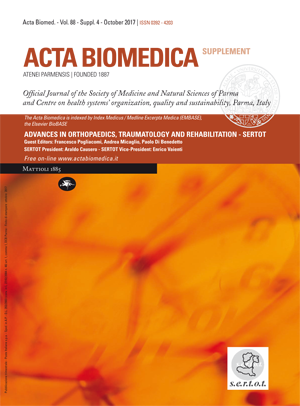Partial repair in irreparable rotator cuff tear: our experience in long-term follow-up
Keywords:
massive rotator cuff tear, irreparable rotator cuff tear, shoulder arthroscopy, partial repairAbstract
Aim of the work: Massive rotator cuff tears are a common source of shoulder pain and dysfunction, especially in middle age patient; these lesions represent about 20% of all rotator cuff tears and 80% of recurrent tears. Some lesions are not repairable or should not be repaired: in this case, a rotator cuff partial repair should be recommended. The aim of the study is to evaluate the outcome of rotator cuff partial repair in irreparable rotator cuff massive tear at medium and long-term follow-up. Materials and method: We have evaluated 74 consecutive patients treated with functional repair of rotator cuff by the same surgeon between 2006 and 2014. We divided patients into 2 groups, obtaining 2 average follow-up: at about 6,5 (group A) and 3 years (group B). In December 2015, we evaluated in every patient ROM and Constant Score. We analyzed difference between pre-operatory data and the 2 groups. Results: We found statistical significant difference in ROM and in Constant Score between pre-operatory data and group A and group B. Between group A and group B there is relevant difference in Constant Score but not in ROM. Conclusions: Partial repair can give good results in a medium follow-up, in terms of pain relief and improvement of ROM, as well as in quality of life. Difference in ROM and Constant Score between group A and group B may indicate the begin of partial repair failure; according to our data, 6-7 years may be the time limit for this surgery technique.
Downloads
Published
Issue
Section
License
This is an Open Access article distributed under the terms of the Creative Commons Attribution License (https://creativecommons.org/licenses/by-nc/4.0) which permits unrestricted use, distribution, and reproduction in any medium, provided the original work is properly cited.
Transfer of Copyright and Permission to Reproduce Parts of Published Papers.
Authors retain the copyright for their published work. No formal permission will be required to reproduce parts (tables or illustrations) of published papers, provided the source is quoted appropriately and reproduction has no commercial intent. Reproductions with commercial intent will require written permission and payment of royalties.







